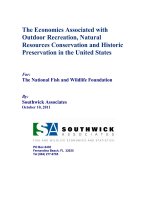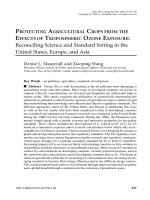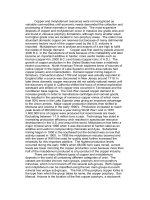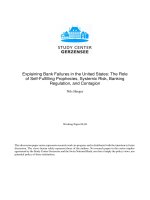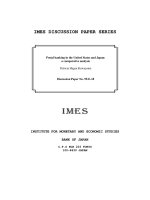banking principles and practice volume 2 the banking system of the united states
Bạn đang xem bản rút gọn của tài liệu. Xem và tải ngay bản đầy đủ của tài liệu tại đây (13.44 MB, 314 trang )
^y-^e?
,'«-*-«'
/.
UNIVERSITY
OF CALIFORNIA
LOS ANGELES
SCHOOL
OF LAW
LIBRARY
Digitized
by
the Internet Archive
in 2007 with funding from
IVIicrosoft Corporation
/>BANKING
PRINCIPLES
AND PRACTICE
By
RAY B. WESTERFIELD,
Ph.D.
Assistant
Professor of
Political
Economy, Yale
University;
Secretary-Treasurer,
American Economic
Association
IN FIVE VOLUMES
VOLUME II
THE BANKING
SYSTEM
OF
THE
UNITED STATES
NEW YORK
THE RONALD
PRESS
COMPANY
1921
Copyright,
1921,
by
The Ronald Press
Company
All Rights Reserved
CONTENTS
VOLUME
n—THE BANKING SYSTEM
OF THE UNITED STATES
Chapter Page
XII
Antecedents OF THE Federal
Reserve System
. .
211
Classification of the Financial
Institutions
The First
Bank of
the
United States
Services of
First Bank to
Government
Dissolution
of
First
Bank
The Second Bank of
the United
States
History
of Second
Bank
Weaknesses in Operation of Second
Bank
Defects
of
Note Redemption System
Services of Second Bank to Commerce
Causes of Dissolution of Second
Bank
State Banks Before the
Civil War
Causes of Panic of
1837
The
Independent Treasury
System
Bases
of
Note Issue Before the
Civil War
Evils
of
Early
Bank Note
Issues
Proposed
Advantages
of National Bank
Note
Issue
The
National Banking
Act
The
Growth of
the National Banking System
Movement
to
Reform
National
Banking System
XIII Federal
Reserve Districts and Membership .
. .
238
The Federal
Reserve
Districts
Boundaries of Federal Reserve Districts
Domestic Branches of Federal
Reserve
Banks
Foreign Branches of Federal Reserve Banks
Membership in Federal Reserve System
Legal Requirements of
Membership
Procedure in Applying for Membership
Growth
in
State Bank
Membership
Objections to
Membership
Reasons for Membership
New Powers of
National
Banks
XIV
Federal Reserve Banks
258
Capitalization of Federal Reserve Banks
Surplus
Earnings
and Operating Costs
The
Board of Directors
Election of
Directors
The
Federal Reserve
Agent
IV
CONTENTS
Chapter
Page
Internal
Organization
Reorganization
of
Federal
Reserve
Bank
of New York
19
19
The
Governor
Powers of
the Reserve Banks
Typical
Bank Departments
Resources
and Liabilities
of
the
Federal
Reserve
Banks
Liabilities of the Federal
Reserve
Banks
Fiscal
Agents of
the United States
The Treasury
and
Reserve Banks
Duties
of
Former
Sub-Treasuries
XV
The
Federal
Reserve Board
285
Membership of
the
Board
Criticism of
Constitution of the Board
Powers
and Responsibilities
Administrative Duties
The
Federal Advisory
Council
The
Comptroller of
the
Currency—Powers and Duties
The
Comptroller's
Examiners
National
Bank
Reports
XVI
Domestic
and Foreign
Branch Banking
296
Branch Banking
Within
the United States
State and National
Branch Banks
Development
of
Branch Banking
Need for
Foreign Branches of
American Banks
Foreign
Branch Banks Established
Ownership and
Management of
Foreign
Branches
Growth and
Functions of Foreign
Branches
Federal Foreign
Banking Associations
Provisions of the
Edge
Act
Powers of
the
Edge
Corporations
Edge Corporations
Established
XVII
Legislation
Governing National
Bank Note
Issue
.
Bond
Deposit Requirement from
1864
to
1900
The
Aldrich-Vreeland Act—
Emergency
Circulation of As-
sociations
Emergency Circulation of National Banks
Character of the Emergency Notes
Effect of War
on
Emergency Circulation
Conversion and
Refunding of
Bonds under
the
Federal
Reserve
Act
Effect of
Liberty Bond Issues on
Bond Refunding and
Conversion
Retirement
of National
Bank
Notes
The Pittman
Act
of
191
8
The Deposited
Bonds
311
CONTENTS
V
Chapter
Page
XVIII
National Bank Notes
328
Preparation of National
Bank
Notes
Denominations
and Character
The Redemption
Fund
Method of
Note
Redemption
Withdrawal of Circulation
Effect
of Liquidation
EflFect
of
Failure to Redeem
upon
Demand
The Tax on
National Bank Notes
Public Advantages of National Bank
Notes
Banking Advantages of National Bank
Notes
Method of Calculating Profit
on
Note
Circulation
Disadvantages of National
Bank Notes
Inelasticity
Other
Disadvantages
XIX
Federal
Reserve Notes
.350
Issue of Federal
Reserve Notes
Methods of
Redemption and
Retirement
Effect of Gold
Reserve Concentration
Amendment
Providing for Direct
Issue
Reserves of
Federal Reserve Banks
Tax on
Deficiency of Reserves
Other Devices for
Obviating Deficiencies
of
Reserves
Movement of
Reserve Ratio
Characteristics of Federal
Reserve Notes
Provisions for Controlling
Excessive Issues
Responsibility for Stemming
Inflation
Safety
of Federal Reserve
Notes
Elasticity of
Federal Reserve
Notes
XX
Discount Operations
OF the Federal Reserve Banks
374
Paper Eligible for Rediscount
1.
Rediscounting for Member
Banks
Effect
of War on
Discount of
Commercial
Paper
Statistical Statement of
the Discounts
2. Open-Market
Operations
3.
Rediscount
Operations
Between
Federal Reserve
Banks
Discount
Rates of
Federal
Reserve Banks
Factors
Influencing
Discount Policy
of Federal Reserve Board
Control
by
Lines
of Credit
XXI Reserves Against Deposits
Under National Banking
Act
387
Legal Requirements
System of Redeposited Reserves
Bank
Correspondents
Effect of
System
on
Concentration of Money
Competition
for
Deposit Balances
VI
CONTENTS
Chapter
Page
Effect
of
Redeposited Reserves on
Securities and
Money
Markets
Effect on
Cash
Carried, Exchange, and
Accommodation
Reserves
and Stock Exchange
Loans
Fictitious
Reserves
Evils
of
Legal Minimum
Reserve
Decentralization
of
Reserves
XXII
Reserves
Against
Deposits
Under the Federal
Re-
serve
Act 400
Legal
Requirements
Amendments
to
Reserve Requirements
Amounts and
Distribution
of
Reserves
Effects
of Federal
Reserve System
on
Reserves
1
.
Reduction of
Reserves
2.
Concentration
of Reserves
3.
Decentralization of
Bank Balances in Central
Reserve
Cities
4.
Cessation of
Interest Payments
on
Reserves
Calculation of
Reserves
of
Member Banks Against Deposits
Definition of
Reserve Cities
Reserves of
the Federal
Reserve Banks Against
Deposits
Nature
of the Gold
Settlement Fund
Operation
of Gold
Settlement
Fund
Functions
and
Transactions of
Gold
Settlement Fund
Telegraphic
Transfer of Funds
Members'
Drafts on Federal Reserve
Banks
The Par
Collection System
Progress of Par
Collection System
Statistical
Statement
of
Deposits in
the
United States
XXIII
Institutions
Other Than National and Federal
Reserve
Banks
426
Composition of
the
Banking
System of
the United States
State
Banks
—Growth
Requirements as to Capital
Limitations
as
to
Loans
Requirements as to Reserves, Branches,
and Supervision
Trust
Companies—Legal Requirements
Growth of
Trust
Companies
Causes of
Recent Growth
Supervision
and
Regulation
Private Bankers
Mutual and Joint-Stock
Savings Banks
Statistical
Statement of the Banking System
of
the
United
States
XXIV
Institutions Other
than
National and
Federal
Reserve Banks (Continued)
443
Postal Savings Banks
School
Savings Banks
CONTENTS
vii
Chapter
Page
Building and Loan Associations
—
Nature
and Organization
Operations and Functions
Statistical Summary
Savings in
the
United
States
The Loan
Shark
Remedial Loan Systems
Morris Plan Banks
Advantages of
Morris
Loan
Plan
Cattle
Loan
Companies
Nature and Terms of
Cattle
Loans
Rediscounting
Cattle Paper
Security
and
Liquidity of
Cattle
Paper
The
Federal Farm Loan System
Federal Land Banks
Federal Farm Loan
Bonds
National Farm Loan
Associations
Joint-Stock
Land
Banks
Federal Farm Loan
Board
XXV
Bank Organization
and
Conversion
469
Introductory
Organization
of
a
New National
Bank
Requirements for Formal Application
Examination of Application
Articles
of Association
and
Organization
Certificate
Election of Directors and Officers
Requirements
as
to Capital Stock Subscriptions
Requirements
as
to Circulation
Reorganization of
a
Bank into a National
Bank
Conversion of a
State
Bank into a
National Bank
Organization of a
State
Bank—Preliminary
Requirements
Authorization
Certificate
Qualifications
of Directors
Organization
of a
Trust
Company
Conversion of a State Bank into
a
Trust Company
Conversion of a Trust Company
Organization
of a Mutual Savings
Bank
XXVI
Charter Changes,
Consolidation, and Liquidation
486
Increasing Capitalization of a
National Bank
Reducing Capitalization of
a
National Bank
Extension of Charter
Change of Name or
Location
Requirements
in
Amending Charter
Reasons for
Consolidation of Banks
The
Agreement of Consolidation
Approval of Consolidation
Methods of Consolidation
Liquidation of
National Banks
Conversion
of
a
National
Bank
into
a
State
Bank
FORMS
AND
ILLUSTRATIONS
Figure
'
Page
4.
The Federal Reserve
Districts
242
5.
Proposed
Type
of Organization for the Federal
Reserve
Banks,
19
18 «66
6. Oflficial Organization of the Federal Reserve Banks of New York . 268
7.
Graphic Chart Showing Reserves of
the
Twelve Federal Reserve
Banks
363
8.
Graphic Chart Showing Seasonal Variations in
Federal
Reserve Note
Circulation
372
9.
Graphic Chart
Showing Earning
Assets
of
the
Federal Reserve
Banks,
1914-1920
376
Banking Principles and
Practice
VOLUME
II
THE
BANKING
SYSTEM
OF THE UNITED
STATES
VOL. II
—
I
ANTECEDENTS
OF THE FEDERAL RESERVE SYSTEM
Classification
of
the Financial Institutions
The banking system of the United
States is dual in the sense
that some institutions are
authorized
by
federal statute
and
charters and other institutions
by state statute and charters, and
the two classes have developed in competition with each
other.
The
financial institutions
to
which
federal
charters are granted
or which operate
under federal law include
:
1. Federal
reserve
banks.
2. National banks, some of which have local or foreign
branches.
3.
Federal
land banks.
4.
Federal
joint-stock
land banks.
5.
National farm
loan associations.
6.
Postal
savings depositories, including branch
post-offices
and stations.
7.
"Edge"
corporations.
8. The
War Finance Corporation.
The
state institutions
are more
varied in their
nature, purpose,
and operations.
They embrace
:
1.
Commercial chartered banks.
2. Private
individual banks.
3.
Trust
companies.
4.
Mutual
or trustee savings banks.
5.
Joint-stock and
"special
deposits"
savings
banks.
6.
Bond houses
and
investment
companies.
7.
Co-operative
savings associations
and
building and loan
associations.
211
212
BANKING SYSTEM
OF THE
UNITED STATES
8.
Morris-plan
banks.
9.
Personal
loan
companies.
10. Personal
loan
brokers.
11. Land
banks.
12. Mortgage
loan companies.
13.
Credit
unions.
14.
Discount
houses.
15.
Acceptance
houses.
16.
Note
brokerage houses.
17.
Finance companies.
18. Cattle loan companies.
The emphasis of
this
book
is on commercial
banking
and the
development of
the federal reserve
system. It is the
purpose of
this chapter to
present the historical
background of
this system.
Non-commercial banks are treated less
fully, the
discussion
of
such institutions being limited to Chapters
XXIII
and XXIV.
The
First Bank of
the
United States
As part of
a
general scheme to support public
credit in
1791,
Alexander Hamilton prevailed upon Congress to
institute
the
first
Bank of the United States. His main arguments
in
support
of the institution were:
1. The demonstrated success and usefulness of
national
banks
in the chief European countries.
2. The
more effective
utilization of capital
by concentrating
the savings of the
community for business
uses.
3.
The possible services of such
a bank to the
government
in
advancing
loans
and
facilitating the
payment of
taxes.
4.
The desirability of
a bank note currency.
The
opposition
to the scheme
was led
by
Madison
and came from
the
southern
states.
The law
provided for
a Bank
of
the United States, located
at
Philadelphia,
capitalized
at
$10,000,000,
with shares
at
$400
each,
FEDERAL
RESERVE SYSTEM—
ANTECEDENTS
213
subscriptions
payable one-fourth
in
specie
and
three-fourths
in
United
States
securities
bearing
6
per
cent
interest
and
payabJe
within two years. The United
States
government
subscribed
$2,cxxD,ooo,
which
sum was loaned by the
bank
to the
government,
the loan
to
be repaid
in
ten annual instalments.
Thus the
pay-
ment of
the government subscription
was effected
by what
were
virtually stock
notes
—
a
very
faulty banking
operation.
The
subscriptions
in
government
securities were
thought
to give
the
bank
a
wider basis
for
note issue than
would
otherwise have
been
possible, as
it would have been difficult
to
assemble
$10,000,000
in gold.
The
bank was
privately
controlled
by a
board of directors
of
25
members,
one-fourth of whom
at
the
end of
each
year became
ineligible
for re-election.
Stockholders
in foreign
countries
could
not vote
by
proxy.
The
votes allowed per
share decreased
with
the
increase
in
the number of shares held
by any one
stockholder,
thus
providing
for
decentralized
control, and
no
subscription,
save
that
of the
government, was to exceed
i
,000
shares.
The
bank was
authorized to issue notes
which were
a legal
tender
in
payment
of all
debts
to the United
States. The
bank's
debts
were
limited
to the amount
of the
capital. This
limitation
could be
exceeded
only
by
authorization of Congress,
and
the
directors
were
personally
liable for the excess.
The bank
was
forbidden
to
trade in
merchandise, it was permitted
to sell
—
but
not
to
buy—
United
States
securities, and
its real estate invest-
ments
were
limited to
its bank
buildings
and
site.
The bank
was
to
make
no
loan to the
United States in excess
of
$100,000,
nor
to any
state in
excess of
$50,000,
nor to any foreign country
without
the
authorization of
Congress. The maximum rate
for
loans
and discounts
was
fixed at 6 per
cent. The directors
were
empowered to
establish
branches
within the United
States.
The bank
was
required to
report its
condition
to
the
Secretary
of the
Treasury at
his
demand, but
not oftener than once
a
week.
The Secretary
of the
Treasury
had the
right
to
inspect the
books
214
BANKING
SYSTEM OF THE
UNITED STATES
of
the bank.
The charter ran for twenty years and
meanwhile
the government
was to establish no other
bank.
In
1792
the
bank
estabhshed in the chief cities
of
the country
eight
branches, among which the
$10,000,000
capital
was
appor-
tioned.
Bank
notes were issued by
the parent bank and
its
branches
in denominations of
$5
and more,
the total amount in circulation
at any one time never exceeding
$6,000,000.
As the parent bank
refused
to redeem
the notes of its branches, this forced each
branch
to be
self-reliant
and tended to
prevent overextension;
this
policy also relieved the parent bank
from
a sudden demand
for large
payment at any one
of
its
branches.
The bank used
"half
-notes" and "post-notes" to
make payments
at a distance.
As
these notes circulated widely, they had a
salutary
effect in
restraining
the overissue
of
notes
by
state banks.
Services
of
First
Bank
to Government
The government enjoyed
many advantages from the bank,
such as the
$2,000,000
loan for its stock
subscription, which bore
only
6 per cent
interest, whereas
the dividend rate on the
stock
was 8 per cent, the
2 per
cent
difference
representing
a net profit
to
the government. The Treasury
also borrowed on
short-term
notes
from the bank.
When by
1795
long-term
loans to the
government amounted
to
$6,200,000,
or nearly
two-
thirds
of
its
entire capital, this concentration
of loans crippled its
services
to
commerce
and industry
and also made it difficult for
the
institu-
tion to help the government
with short-term
accommodation.
To liquidate its
debt to the bank the government,
between
1
797
and
1802,
sold its shares of the bank's
stock
—at premiums
aggre-
gating
$671,860.
Meanwhile
the government
had
received
dividends amounting
to
$1,101,720.
The relations
between the Treasury
and
the bank were
in-
timate. The bank granted loans
to the
Treasury,
helped
it to
perform its foreign
exchange business—
for
the bank
did most of
FEDERAL
RESERVE SYSTEM—ANTECEDENTS
215
the foreign
and domestic exchange business of the country
—acted
as government depository,
paying no interest on the
public
de-
posits, and
in compensation
for
the use of the deposits
transmitted
pubhc moneys from place
to
place free of charge. In
addition the
bank was of
service to importers in
the
payment of
custom duties,
which were
commonly paid in post-notes. After
1800 the
Collec-
tor of the Internal
Revenue used the bank as well as its
branches
to
collect the
maturing revenue bonds, promoting thereby
greater
punctuality and economy in the service.
Dissolution of First Bank
Because the bank was regarded
as a
FederaHst
institution,
Jef-
ferson
and the Democrats were
opposed to
it,
yet
the
institution
was managed capably and with
a view to
profits
and kept
aloof
from
political controversies. Gallatin, who pleaded the
bank's
cause with
Jefferson,
was willing
to
waive political
objections
in
consideration of the fiscal and business
advantages
of
its
opera-
tion, and in 1808 when the
original charter was
soon
to expire
he
ad-
vocated
its
renewal. The objection which weighed most
heavily
against
the bank was the large holdings of the bank's
stock abroad
and the consequent
payment of dividends to
foreigners.
The
trade
organizations
of the country in general favored
the renewal
of the
charter but state jealousy of the national
institution
and
the repressive effect of
the bank and its branches on the
smaller
new state
banks,
served
to
fan
political
opposition.
As
a result
Congress refused
to renew the charter, and in 181 1
the bank
closed.
Its
officials attempted
to
procure
a
state
charter
for
it
in
Pennsylvania,
but
failed.
They obtained one, however, in
New
York under the
name, Bank of America, and the concern
con-
tinued to do
business as
a
state institution.
The first
Bank of the
United States
failed of
success be-
cause
of
political opposition,
despite the fact
that
it
had
served
well
both the
government and the financial
and
commercial
world.
2l6
BANKING
SYSTEM OF THE UNITED STATES
The Second Bank of
the United States
After the
dissolution
of the first Bank
of the
United
States
and
during
the war
against Great Britain,
the
money market
became
badly
disorganized, specie payments
were suspended
except
in New
England, and
the
public credit sank
to
a low
ebb.
A demand
for the
re-establishment of the
bank
arose
spontane-
ously,
the
main reason
being
to restore to the
country
an orderly
currency
through the
resumption
of specie
payments.
Accord-
ingly a
bill was
passed in
1816 creating
a
new bank,
with
a charter
to
run
for
twenty years.
The new
bank was
capitalized
at
$35,000,000,
in
$100 shares,
one-fifth
to be
subscribed by the government
and four-fifths
by pri-
vate
subscribers.
No one subscription was
to exceed
$390,000.
Subscriptions
were payable
within
a year, one-fourth
in
specie,
and the
remainder
in either specie or
government
bonds. The
board of
directors consisted of
25
members,
5
of
whom
were
ap-
pointed
annually by
the President of the United
States from
several
states, and
the other
20 by
the
stockholders
under
a
system
of restricted
voting.
Not
all the directors
were
eligible for
re-election
and no
director
could be a
director of
any other
bank.
The
bank was
authorized
to deal
in bills
of
exchange
and
bullion
and to
sell goods
pledged for loans,
but was not
to deal
in
any
public
stock. Loans
to the United
States were
limited
to
$500,000,
and to
any state to
$50,000.
Debts, excluding
deposits,
were not
to exceed
the capital.
The
smallest
denomination
of
bank note
issued
was
$5.
All bank
notes below
$100 denomina-
tion were
payable upon
demand, and were
legal tender
in
pay-
ments to
the government.
The larger
notes could run for
terms
up to
60
days. The
organization of branches
of the
bank
was
required
under
certain conditions, and control of the
branch
was
lodged
with
the parent
institution
by the
appointment of
the
branch
directors.
The
bank was
required
to
transmit
public moneys
at par
and
free
of charge.
The Treasurer
was
directed
to deposit the govern-
FEDERAL RESERVE
SYSTEM—
ANTECEDENTS
217
ment funds
in
the
bank
or its branches;
and if for
any
reason
he
did
not do so, he was to
report
the reasons
to Congress.
In case
of
the suspension
of
specie payments, the
obligations
of the
bank
were subject
to
1
2
per
cent interest until
resumption
of such
pay-
ments. The bank was
to
make periodical
statements,
not more
often than
once a
week, to the Secretary of the
Treasury,
and he
was
empowered
to
inspect its books.
A bonus of
$1,500,000
was
levied upon the bank for its franchise.
History
of Second Bank
Professor Dewey summarizes
the
history of
the
bank
some-
what
as
follows. The bank was chartered
on
April
10,
18
16,
and
on
April
30
Congress
ordered the resumption of
specie
payments
to go into effect on February
20, 181
7.
The
bank
was
quickly
organized imder the presidency of one
Jones,
and
began operations
in
January,
1 8
1
7
. Owing to
mismanagement,
Jones
was forced
to
resign in
1818,
and
Langdon Cheves
became
president.
He held
ofSce until
1823,
when he
was succeeded by Nicholas Biddle.
In
June,
1829,
Senator Woodbury
of New Hampshire brought
com-
plaints against
Jeremiah
Mason,
manager of the
Portsmouth
branch;
in the following December
President
Jackson
in
his
an-
nual message
questioned the constitutionality of the bank
and
accused
it
of failing
to
establish
a
sound currency.
On
April
30,
1830,
a
committee
of the House of Representatives
reported
at
length
on
the questions
raised by
Jackson,
its conclusions
being
entirely
favorable to the
bank. A
Senate
report
was likewise
friendly.
In
1831
Senator
Benton supported
a
resolution
against
rechartering
the bank. In
January,
1832,
the
bank petitioned
for
recharter.
This petition was
favorably
acted upon by committees
of the
Senate and
the
House and
a
bill
for
recharter
was passed.
The bill,
however, was vetoed
by
Jackson,
July
10,
1832.
In
the
autumn
of
the same year
Jackson
was re-elected
President,
and
he interpreted
the
vote as
an
indorsement of
his opposition
to the
bank.
In December,
1832,
he raised the
question as to whether
2l8
BANKING
SYSTEM
OP
THE UNITED
STATES
the
funds of the
government
were safe in the custody
of
the bank.
An
investigation
was ordered by the House, and
a
majority
report
of the
Committee on
Ways and
Means
upheld the
poHcy of the
bank and
was
adopted
March
2,
1833,
by a vote of
109
to
46.
Notwithstanding
this
recommendation
the
President
determined
to
remove the
deposits,
and in order to accompHsh
his
purpose,
on
September
23
he
dismissed Duane, Secretary
of the
Treasury,
who
objected to the
removal,
and
appointed
Taney in
his
place.
The
latter, on
September
26,
ordered
that
deposits
henceforth
be
made
in certain
state banks, and on
December
3,
1833,
he
re-
ported to
the Senate
his reasons
for their
removal. In
1836
the
charter
of the
bank expired.
Weaknesses in
Operation of Second
Bank
A
number
of
weaknesses developed in the
operations
of the
second
bank during its
earlier years. The subscription
to its stock
by means
of stock notes was a
mistake in that
the method
of
pay-
ment amounted to a
margin purchase
of
the stock and
was there-
fore speculative
in character; besides, the payments on the
notes
were very
dilatory
and
renewals were freely
made.
Friction also developed
with the state banks
over the transfer
of
public deposits and over
the credit
to be
given
to state bank
notes.
The
state
banks, with the
exception of
those in
New
York,
Philadelphia, and Baltimore,
refused
to help the national
bank effect the resumption
of specie payments, and when this
resumption was accomplished
without their help they
became
embittered. When the
national bank charged
the delinquent
banks
interest on overdue
balances, they regarded
this as "an
unprecedented
grievance." The
withdrawal of
government de-
posits
from
a
state bank usually led to a
collision,
not with the
Treasury but
with
the
national bank
with
which the
funds
were
placed.
A controversy which centered
in the West,
where inflation had
been
carried further than elsewhere,
arose
over the acceptance of
FEDERAL RESERVE
SYSTEM—
ANTECEDENTS 219
state
bank notes tendered
in payment
of
public revenues. The
Treasury and the bank instead
of
co-operating
in the matter
worked
at
cross-purposes.
The Treasury
permitted the
collec-
tors
of internal
revenue
to receive
state bank
notes, the collection
of which
was thrown upon the
national bank.
This responsibility
brought
the
latter
into collision with
the state banks, which were
unable or
unwilling to redeem
promptly. The
national
bank
held
that
whatever loss
was incurred in
the collection of the notes
should
devolve upon the Treasury,
but the Treasury threatened
to
remove
all public deposits
rather than deprive
the people
of
the
means
of paying for public
lands
and
for
their taxes. Natur-
ally
this
dispute
also
contributed
to
the
unpopularity of
the
national
bank.
Political
expediency
as
well
as
the
terms of
the charter
de-
manded
that
many branches be
established, and
27
in
all were
founded.
Almost
every state
had at least
one,
and this
was too
many
for
the
best
business
efficiency.
Losses were greater in
the
branches
than in
the parent
bank, for the
reason that they were
run
more
loosely
and their management
tended
to
yield
to local
pressure
for
favors
in operation
and
policy.
The
branches were
established
with an eye
to equalizing
banking facilities over the
country
and
consequently excessive amounts
of cash were trans-
ferred
to the
South and
West.
Despite the number of branches,
however,
it was
impracticable
to open one in every collection
district,
and
this was a
further
cause of complaint.
The
volume
of
deposits fluctuated
widely from month to
month
and
this
fluctuation was a very disturbing factor
in
the
bank's
loan
operations.
The original theory
was
that the bank
and its
branches were a
unit and, since the bank was
required
to
transmit
government
funds free of charge, the Treasury drew
upon
the
bank at
any place
where
public
money
was
deposited,
whether
public fimds
happened to be there at
that time or
not,
it
being
understood
that
the Treasury would
give the bank reason-
able
notice
of
withdrawal so that
provision
might
be
made for
220
BANKING
SYSTEM OF THE UNITED STATES
meeting the draft. Trouble
soon arose between the bank and
the
Treasury because of lack of sufficient
notice, but
later
a
schedule of
lengths of notice was arranged. The transfer of public moneys by
the bank was
a
convenient arrangement for the government, and
better
than any that could
have
been
provided
by
the state banks.
Defects of Note Redemption
System
Though
the original system of bank note redemption
aided in
effecting resumption
by forcing
the
state banks to
improve the
standing
of their
notes and created
a
good national
currency
accepted everywhere, it was nevertheless defective.
The parent
bank
agreed to redeem its own notes and those of the
branches
north of
Charleston, without distinction,
at any
branch. One
result was that the
parent bank did not know
where or when
notes
were likely
to be presented. Loans were also created freely
by
certain branches,
for the loaning branch knew that its notes
would
be presented elsewhere
for redemption.
In consequence,
sudden and great
demands were made,
varying with the balance
of trade, and it
became useless for any one branch to be
conserva-
tive.
For these
reasons the system broke down in
1818,
and
the
bank resolved
that no branch should take the notes
of other
branches except in
payments due to
the United States.
It
further resolved that
no branch should reissue notes
of the parent
bank
or other branches except when it was a
creditor of the other
bank,
and
then
only when the exchanges
indicated that such
reissue was for the interest of the parent bank. By
making notes
of
$5
denomination
issued by any
branch or
by
the
parent bank
acceptable
at the others, however, a
good currency was
provided.
But
the
burden of signing these notes
of small
denomination
was
so
great that
the bank officers
sought relief from Congress;
failing
to secure this relief the bank in
1827
invented
"branch drafts,"
in
$5
and
$10
denominations. These
drafts were
signed by the
branch president
and cashier, and
drawn upon
the parent bank;
FEDERAL
RESERVE SYSTEM—
ANTECEDENTS
221
they resembled bank
notes in form, were indorsed
payable
to
bearer,
and circulated freely,
supplanting the notes
in certain
areas.
Their issue, however,
was a leading cause of
complaint
against
the parent bank,
because such drafts were held
to be
con-
trary to
the provisions of the bank's
charter and harmful
because
they
contracted
the
circulation of the state
banks.
Services
of
Second Bank to Commerce
The second Bank of
the United States
operated in domestic
exchange,
the
sale
of
drafts to the public constituting
no
small
part of its business. The public and the Treasury
argued that the
bank
ought to sell these drafts
at
par;
but
the
bank charged
vary-
ing
rates of exchange, averaging
yi
per cent. These varying
rates
gave
rise
to
the complaint that the bank showed
favoritism and
that it charged
excessive
and
usurious
rates. After
1820,
how-
ever,
the bank bought
bills
heavily and increasingly,
and this
helped to facilitate
commerce and
to
equalize
exchange. In this
business it competed with the state
banks. The
exchange
opera-
tions
gave the bank
a
considerable control over
the
local
currency
by
purchasing,
or
refusing to
purchase, bills from the
different
areas.
During
the first few years
of the second bank's existence
its
services to commerce were restricted
through the tying
up
of
an
undue
proportion of its capital
in
stock notes received for sub-
scriptions. With the change of management,
however,
its service
improved
and
commercial
loans of short-term usance were readily
granted,
mostly
on pledge
of personalty. Not
only
by aiding
commerce in
this
and other ways,
but also by its
influence
upon
the state
institutions, the bank proved its
value
to
the commun-
ity as a
national institution.
Causes
of Dissolution of
Second
Bank
The opposition which brought
the bank
to
an untimely end
was largely
inspired
by political
intrigue and by
selfish
jealousy
222
BANKING SYSTEM OF THE
UNITED
STATES
on
the part of the state
banks. The charges of
Jackson
and
other
critics were that
some of its officers who were incompetent
were
retained
in office by political
influence, that it tried
to
influence
political
elections
and
state
legislation, and
that some
of
the
branches
were
established for political effect. It
was
further
alleged
that
the
bank
was
monopolistic
and
undemocratic in
character
and therefore
dangerous
to our institutions. On other
grounds
it was argued that the bank was unconstitutional.
Some
of its
banking operations were held
to be
objectionable and
violations
of
its charter, such, for
instance, as the use
of branch
drafts,
the practice
of usury
in exchange
dealings, the sale of
coin,
trading
in
public securities,
speculation in real estate,
and
the like.
The
aggressive
and peculiar character of
the
Democratic
President,
with
his
large political following from the West and
South,
really
explains why the inconsequential charges
brought
against so
serviceable
and successful an institution led to its
dissolution.
State
Banks
Before the Civil War
Banking
in the United States really dates from
1781,
when
Robert
Morris, Superintendent of Finance of the Revolution,
founded
the Bank
of North America
at
Philadelphia
to
promote
the
financing of Washington's army.
The institution was char-
tered
by
the
Continental Congress and
was organized as
a
means
of
creating
credits based
upon
the small amount
of specie that
existed
and of
making advances to
the government. It
was a
complete
success as a war
measure and had a
benign
com-
mercial
influence as well. In
1782
it
was
chartered as a state
bank
in Pennsylvania, and
under this charter, renewed from
time to
time, it enjoyed
a
very successful
career until
1864,
when it became a
national bank,
and is still
a
leading bank of
Philadelphia.
In
1784
Massachusetts chartered
the Bank of
Massachusetts,
and in
New York, under
Hamilton's
influence, the
Bank
of New
FEDERAL RESERVE
SYSTEM—
ANTECEDENTS
223
York was
founded
and put
into
operation
but the
state
refused
to
grant it
a
charter
until
1791.
The tendency
in both
these
states, as
time
passed, was to lay heavier
restrictions
upon
their
banks. The
restrictions included the
imposition
of
personal
Hability upon
directors
for any violation of
the
law
that
debts
should not exceed
some specified multiple of the
paid-in capital,
the
limitation
of notes to large denominations,
the
prohibition
of
dealing
in merchandise
or stocks,
and
the
requirement
of
reports
of
condition.
By
the year 1800
the number of
state banks
had
increased
to
28,
and by
181
1,
to
88.
This
rapid increase,
though it
indicated
the need
of credit
institutions, was also
a
leading
cause
of the
opposition to
the
rechartering of
the first Bank
of
the United
States.
In the
period from 1812
to
1816
the Treasury
of the
United States
employed
the
state banks as
depositories
of the
public funds.
The poor conduct of the national
finances,
particu-
larly
the failure to
levy taxes,
the heavy issue of
Treasury
circu-
lating notes, and
the drain of specie abroad
precipitated
suspen-
sion of specie payments by
all
state
banks,
except
those in
New
England, and
tied
up
the government deposits.
The failure to recharter
the
first Bank of the
United States
left the field
free
to
the state
banks,
which increased
from 88 in
181 1
to
246
in
1 81
6,
and expanded their bank
note issues to
$ioo,CHDo,ooo. These
banks were organized
on
very
defective
credit principles,
the loans being based
heavily
upon
lands
and
government
securities.
The export of specie due
to
the adverse
balance
of
trade
made
the situation still worse.
The Treasury
op)erations were
thrown into confusion by
the disordered
currency.
At
this juncture, in the
year
1816,
the demand
for
a second Bank
of the United States
became
strong enough to force Congress
to
grant a charter.
From its
organization in
181
6 down
to
1834,
the
year in which
the second
Bank of the United States
was
refused
an extension
of
its
charter, the state
banks grew in
number.
Good
statistics
are


